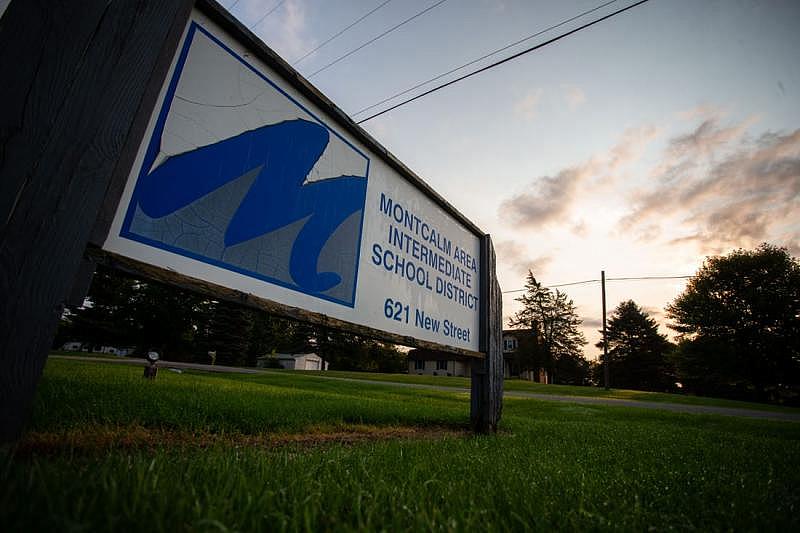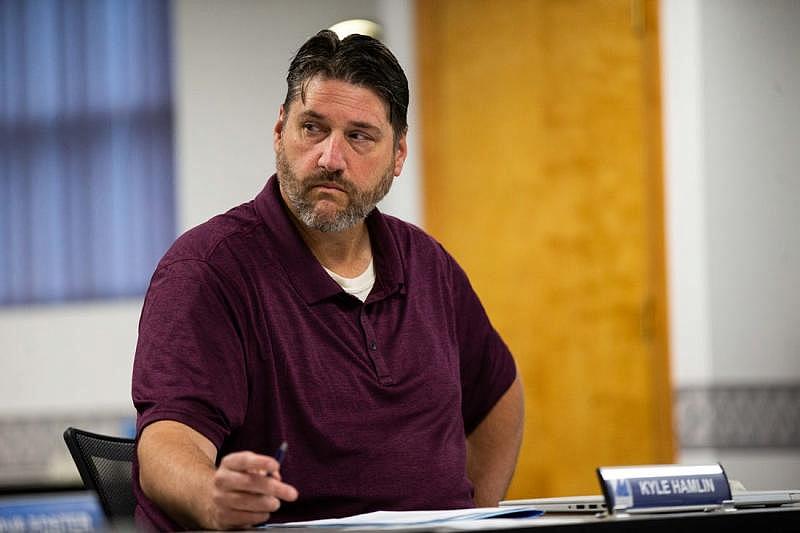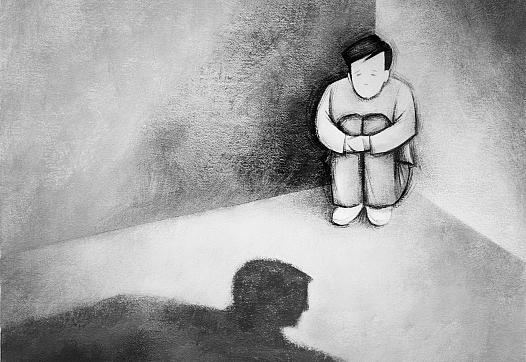Small school district in Michigan's Montcalm County isolated kids 4,000 times in 5 years
The story was originally published in Detroit Free Press with support from the USC Annenberg Center for Health Journalism's 2022 National Fellowship.
A small school district in central Michigan isolated children with disabilities in rooms more than 4,000 times over the last five school years — the most by far of any Michigan school district — and administrators will not reveal why.
Instead, leaders of Montcalm Area Intermediate School District say their treatment of some of the most vulnerable children is necessary and that their high numbers could be attributable to record keeping that is “beyond reproach.”
Intermediate school districts, including Montcalm, offer specialized programs for students with disabilities who reside in their respective counties.
It is unclear why Montcalm, a rural district of about 480 students midway between Grand Rapids and Saginaw, used seclusion so many more times than other districts that reported to the state. The district also uses restraint, another tactic that involves adults using force to restrict a child's movement, but educators there used seclusion far more often, the numbers show.
Montcalm in the 2021-22 school year secluded or restrained 39% of its students with disabilities, a rate that far outpaces other districts in the state. The next highest districts — Allegan Area Educational Service Agency, Kalamazoo Regional Educational Service Agency, Van Buren Intermediate School District and Shiawassee Regional Education Service District — secluded or restrained 10% of students with disabilities.
Many districts in Michigan recorded no numbers. Montcalm officials have twice denied a Michigan Freedom of Information Act request from the Free Press for documents that would help explain the district’s actions.
State data provides the number of seclusions but no details on key issues like how long students were held or why educators decided the tactics were necessary. Montcalm officials say they are protecting student privacy when refusing to release those records, though the Free Press wasn’t seeking names.

The Montcalm Area Intermediate School District has used seclusion practices on its student body more than 4,000 times over the past five school years. CODY SCANLAN/HOLLAND SENTINEL
Out of Michigan’s nearly 900 school districts and charter schools, Montcalm is just one of 11 to use seclusion more than 1,000 times from the 2017-22 academic years. About 160 children with disabilities attend Montcalm programs, according to state data.
The number of times Montcalm used seclusion has increased every school year since 2017, with an exception in 2020-21, when many schools were closed for in-person learning due to the pandemic.
Seclusion involves restricting students — often in crisis — to a room by themselves while an adult supervises outside. Seclusion rooms are often small and bare, with a window where adults can peer inside. A small, rectangular seclusion room used by Montcalm ISD has padded cinder block walls with a fluorescent light overhead — an image the district provided in response to a public records request is grainy and shows only a portion of the room.
State laws passed in 2016 required educators to use seclusion — and another form of control, restraint — only as a last resort in the case of an emergency, such as a student endangering themselves or others. The law also requires districts to document the practice and report data to the state, including justification for secluding a child.
Every time an educator secludes a student, state law requires them to fill out a document specifying how long the student was placed in seclusion, why the student was placed in seclusion and other information. Other school districts have provided these documents to the Free Press, removing student names to conceal their identities.
A review of documents from other districts shows educators have used seclusion not just in an emergency, but as punishment for unwanted behavior. Inside the seclusion rooms, students often become more anguished. Some are denied the ability to use the restroom. Others stand at the doors and wail, at times pounding on doors and walls while screaming to be released.
Students often behave erratically in the moments before they are confined to these rooms, throwing furniture or hitting a teacher. But the practice of seclusion is controversial, and many experts say it is unnecessary, inflaming disruptive behavior and impeding learning. Parents of students who have experienced seclusion say their children are traumatized by it.
In Montcalm, while remaining mum on why they’ve used the practice so often, administrators did share their restraint and seclusion policy, which reiterates Michigan law on the practice.
In addition to denying records requests, Montcalm Superintendent Kyle Hamlin and Daniel Brant, associate superintendent of special education, refused to answer questions posed by Detroit Free Press reporters via email, over the phone and in person at a school board meeting about Montcalm’s use of seclusion, citing privacy concerns. The questions did not ask about specific students.

Daniel Brant, the associate superintendent of special education, speaks during a Montcalm Area ISD board meeting Thursday, Sept. 15, 2022. Brant declined to answer questions regarding the district's policy regarding the use of seclusion. CODY SCANLAN/HOLLAND SENTINEL
The administrators also did not answer questions about the publicly funded district’s operations, including one asking them to describe Montcalm’s programs for students with disabilities.
Hamlin said the district is complying with state law when it comes to seclusion.
“Maybe we’re the district that’s doing it right. … I have an associate superintendent who requires all incidents to be reported, regardless, very much by the book,” Hamlin said during a phone call in August. “I know that we certainly are beyond reproach when it comes to stuff like that.”
Free Press reporters appealed Montcalm’s FOIA denial in November and July to the district’s five-member school board. In January, four board members voted to deny the appeal, with one voting in favor of releasing the documents, according to the Daily News, a newspaper based in Montcalm County.
At that meeting, Hamlin said the district uses seclusion in instances where a student is “having a bad day,” according to the Daily News.
“That could be as simple as having a student who is having a bad day who needs to be isolated from others,” he said, according to the newspaper. “It’s generally going to be for the safety of self and safety of others. But in some cases, you might have to restrain a student as well.”

Montcalm Area ISD Superintendent Kyle Hamlin listens during a board meeting Thursday, Sept. 15, 2022, in Stanton, MI. Hamlin has declined to elaborate on the district's use of seclusion on its student body of fewer than 500 students. (Photo: Cody Scanlan/Holland Sentinel) CODY SCANLAN/HOLLAND SENTINEL
Trina Tocco, director of the statewide advocacy organization Michigan Education Justice Coalition, disagrees with Hamlin.
“Does he go into seclusion when he’s having a bad day?” she asked, after hearing Hamlin’s comment. “My concern as a parent would simply be, frankly, my kid has a bad day every day. … I'd be curious what sort of statistics they have that this process is actually working? Is it making it any better, right? Are they seeing improvements in fewer bad days?”
Hamlin said the district decided to deny the records to the Free Press citing FERPA, a federal law meant to protect education records of students. Kurt Peasley, the board member who voted to release the records, alluded to legal advice the board had received in a closed part of the meeting suggesting it could release the records.
A 2019 unpublished opinion by the Michigan Court of Appeals in a case out of Kalamazoo involving student bus records stated that FERPA laws don’t stop districts from releasing records with certain information redacted, or deleted, from a document. A judge wrote that when information is redacted, “the record no longer satisfies the definition of an education record under FERPA.”
At a Sept. 15 school board meeting, Board President Steve Foster said he hadn't had parents or educators contact him about any concerns with the district’s use of seclusion or restraint. He said he’d seen a seclusion room, but declined to describe what the room looks like or to answer any additional questions from a Free Press reporter.

Montcalm Area ISD Superintendent Kyle Hamlin listens to board President Steve Foster during a September board meeting Thursday, Sept. 15, 2022, in Stanton, MI. The district of fewer than 500 students has used seclusion practices more than 4,000 times over the past five school years. District officials have declined to answer questions regarding the practice of seclusion on its students. CODY SCANLAN/HOLLAND SENTINEL
“You have to understand that the student population that we serve is different than public schools, other schools, charter schools and so forth,” he said. “We have emotionally impaired (students).”
Larger ISDs in Kent, Macomb and Genesee counties that serve more students reported using seclusion and restraint thousands of times fewer than Montcalm ISD. But Brant suggested it was inappropriate to compare Montcalm data even with other ISDs.
“Kent doesn’t operate programs the way that we do,” he said when asked why his ISD would have far more instances of seclusion and restraint than others.
Kent, like Montcalm, operates a program for students with disabilities, reporting 1,062 instances of seclusion over five school years. Kent serves 3,626 students and 1,332 students with disabilities, according to state data.
Brant said the Montcalm district is particularly concerned with concealing the identities of the children secluded thousands of times.
“In our county, we service some significantly violent students, and because we’re a small ISD … we need to protect their identity,” he said.



